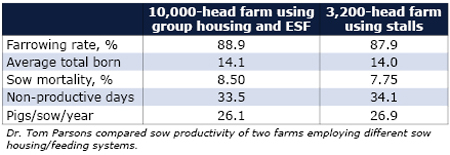
Group housing for sows: Can it be done effectively?
 By Dr. Dean Koehler
By Dr. Dean Koehler
With a lot of pressure to move toward group housing for sows, Dr. Tom Parsons, associate professor of swine medicine in the Department of Clinical Studies – New Bolton Center, University of Pennsylvania School of Veterinary Medicine, joined us at the Vita Plus Swine Summit to share his insight. Parsons studies animal health, productivity and welfare. Parsons was instrumental in the establishment of the school’s swine teaching and research center, featuring a variety of animal-friendly technologies, including group sow housing utilizing electronic sow feeders (ESFs). This facility has served as a prototype for the commercial-scale implementation of pen gestation, and Parsons has helped more than 40 farms transition from stalled gestation systems to pen gestation. The sow inventory of these farms ranges from 100 to 10,000 sows, and more than 80,000 U.S. sows are now managed using the Penn Gestation Housing system. Individual feeding of sows is the primary production advantage that leads to the nearly universal use of gestation stalls. Parsons did not want to give up this individual feeding advantage when moving to group housing of sows, so he chose to work with ESFs rather than one of the common competitive sow feeding systems (floor-drop feeding or stanchions with trickle feeding). Parsons explained that the individual sow feeding advantage is even higher for ESFs than it is for gestation stall systems. This is because, despite the fact that stalled sows have individual feed hoppers, when the feed is dropped it ends up in a continuous feeder where sows can steal from their neighbors. He has found that sows fed using the ESF system require 0.2 to 0.5 pounds less feed per day than stalled sows to maintain similar sow condition and productivity levels. Conversely, sows in competitive-feeding systems require 0.2 to 0.5 pounds more per day than stalled sows to support similar levels of body condition and production. Parsons pointed out that group housing systems may not be right for everyone, but for those willing to take on the challenge, excellent levels of performance can be attained. Loose sow housing using electronic sow feeders (ESFs) versus traditional gestation stalls.  Parsons presented what he called his four pillars of the loose sow housing decision, namely:
Parsons presented what he called his four pillars of the loose sow housing decision, namely:
- Project type
- Barn flow
- Pen design
- People
He described the first three of these as “easy,” meaning you only need to get them right once. He described the “people,” or the ongoing management factor, as “hard” because that has to be done right every day. New challenges that must be faced when moving to loose sow housing systems with ESFs include: gilt training to use of the ESF, RFID tag management (if a sow loses a tag, she can’t eat), and computer literacy to manage the ESF. However, Parsons observed that the challenge of computer literacy might actually work in favor of stimulating the interest of younger, computer-savvy people to want to be involved in sow management with ESFs. This article was originally published with the Vita Plus Swine Summit 2013 E-news. Dr. Dean Koehler has served as swine technical services manager since joining Vita Plus in 2001. He was raised in southwest Minnesota and was active in 4-H and FFA. His youth livestock projects included raising and showing swine and sheep. Koehler earned his bachelor’s degree in animal science and his master’s degree and Ph.D. in swine nutrition from the University of Minnesota. His master’s research investigated the digestibility of raw soybean varieties naturally low in anti-nutritional factors when fed to growing pigs. His doctorate research utilized a stable isotope of the amino acid lysine to measure how efficiently sows transfer dietary lysine into their milk. Koehler is interested in all facets of swine nutrition. His role at Vita Plus is to provide technical service to the field and supervise the development of support tools, such as technical bulletins and spreadsheets. Additionally, he is the author the Vita Plus online grow-finish feed budgeting software, mentor.
| Category: |
Facility design Swine Performance |

